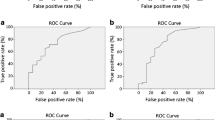Abstract
This study aimed to evaluate a laser fluorescence device (the DIAGNOdent) and a visual classification system (ICDAS-II) for occlusal caries diagnosis. It also aimed to determine whether fluorescence measurements taken at the tooth surface correlate with the fluorescence measurements taken within the body of the lesion. The occlusal surfaces of 100 extracted permanent teeth were examined using ICDAS-II and DIAGNOdent (LF-tooth). Serial sections were made and lesion depth was assessed histologically. DIAGNOdent readings were also taken from the sections (LF-section). There were significant positive strong correlations between ICDAS-II and histology (rS = 0.71) and LF-section and histology (rS = 0.70), and only moderate correlations between LF-tooth and histology (rS = 0.51) and LF-tooth and LF-section (rS = 0.60). Diagnostic accuracy for ICDAS-II was generally better than for LF-tooth. While the DIAGNOdent device provides an objective reading for detection and monitoring of carious lesions, using the cut-off ranges previously suggested leads to inferior performance.




Similar content being viewed by others
References
Downer MC (1975) Concurrent validity of an epidemiological diagnostic system for caries with the histological appearance of extracted teeth as validating criterion. Caries Res 9:231–246
Stübel H (1911) Die Fluoreszenz tierischer Gewebe im ultra-violetten Licht. Pflugers Arch 142:1–14
Buchalla W, Attin T, Niedmann Y, Niedmann PD, Lennon ÁM (2008) Porphyrins are the cause of red fluorescence of carious dentine: verified by gradient reversed-phase HPLC (Abstract). Caries Res 42:223
Lussi A, Hibst R, Paulus R (2004) DIAGNOdent: An optical method for caries detection. J Dent Res 83(Spec Iss C):C80–C83
Lussi A, Imwinkelried S, Pitts NB, Longbottom C, Reich E (1999) Performance and reproducibility of a laser fluorescence system for detection of occlusal caries in vitro. Caries Res 33:261–266
Hibst R, Paulus R, Lussi A (2001) A detection of occlusal caries by laser fluorescence: basic and clinical investigations. Med Laser Appl 16:205–213
Pitts N (2004) “ICDAS”- an international system for caries detection and assessment being developed to facilitate caries epidemiology, research and appropriate clinical management. Community Dent Health 21:193–198
Jablonski-Momeni A, Stachniss V, Ricketts DN, Heinzel-Gutenbrunner M, Pieper K (2008) Reproducibility and accuracy of the ICDAS-II for detection of occlusal caries in vitro. Caries Res 42:79–87
Jablonski-Momeni A, Ricketts DN, Stachniss V, Maschka R, Heinzel-Gutenbrunner M, Pieper K (2009) Occlusal caries: evaluation of direct microscopy versus digital imaging used for two histological classification systems. J Dent 37:204–211
International Caries Detection and Assessment System (ICDAS) Coordinating Committee: The rationale and evidence for the International Caries Detection and Assessment System (ICDAS II) & Criteria Manual, Baltimore 2005 (www.icdas.org)
Stachniss V (2005) Zur Hartschnitt-Technik nicht entkalkter Zähne und digitale makrofotografische Reproduktion histologischer Präparate. Research Report, Philipps-University Marburg, Germany
Bland JM, Altman DG (1999) Measuring agreement in method comparison studies. Stat Methods Med Res 8:135–160
Lussi A, Hellwig E (2006) Performance of a new laser fluorescence device for the detection of occlusal caries in vitro. J Dent 34:467–471
Ricketts DNJ, Watson TF, Liepins PJ, Kidd EAM (1998) A comparison of two histological validating techniques for occlusal caries. J Dent 26:89–96
Bader JD, Shugars DA, Bonito AJ (2001) Systematic reviews of selected dental caries diagnostic and management methods. J Dent Educ 65:960–968
Ricketts DN, Kidd EA, Smith BG, Wilson RF (1995) Clinical and radiographic diagnosis of occlusal caries: a study in vitro. J Oral Rehabil 22:15–20
Rodrigues JA, Diniz MB, Josgrilberg EB, Cordeiro RC (2009) In vitro comparison of laser fluorescence performance with visual examination for detection of occlusal caries in permanent and primary molars. Lasers Med Sci 24:501–506
Diniz MB, Rodrigues JA, de Paula AB, Cordeiro RC (2009) In vivo evaluation of laser fluorescence performance using different cut-off limits for occlusal caries detection. Lasers Med Sci 24:295–300
Bader JD, Shugars DA (2004) A systematic review of the performance of a laser fluorescence device for detecting caries. J Am Dent Assoc 135:1413–1426
Francescut P, Zimmerli B, Lussi A (2006) Influence of different storage methods on laser fluorescence values: a two-year study. Caries Res 40:181–185
Ricketts DNJ, Ekstrand KR, Kidd EA, Larsen T (2002) Relating visual and radiographic ranked scoring systems for occlusal caries detection to histological and microbiological evidence. Operative Dent 27:231–237
Souza-Zaroni WC, Ciccone JC, Souza-Gabriel AE, Ramos RP, Corona SAM, Palma-Dibb RG (2006) Validity and reproducibility of different combinations of methods for occlusal caries detection: an in vitro comparison. Caries Res 40:194–201
Rodrigues JA, Hug I, Diniz MB, Lussi A (2008) Performance of fluorescence methods, radiographic examination and ICDAS II on occlusal surfaces in vitro. Caries Res 42:297–304
Author information
Authors and Affiliations
Corresponding author
Rights and permissions
About this article
Cite this article
Jablonski-Momeni, A., Ricketts, D.N.J., Rolfsen, S. et al. Performance of laser fluorescence at tooth surface and histological section. Lasers Med Sci 26, 171–178 (2011). https://doi.org/10.1007/s10103-010-0768-y
Received:
Accepted:
Published:
Issue Date:
DOI: https://doi.org/10.1007/s10103-010-0768-y




